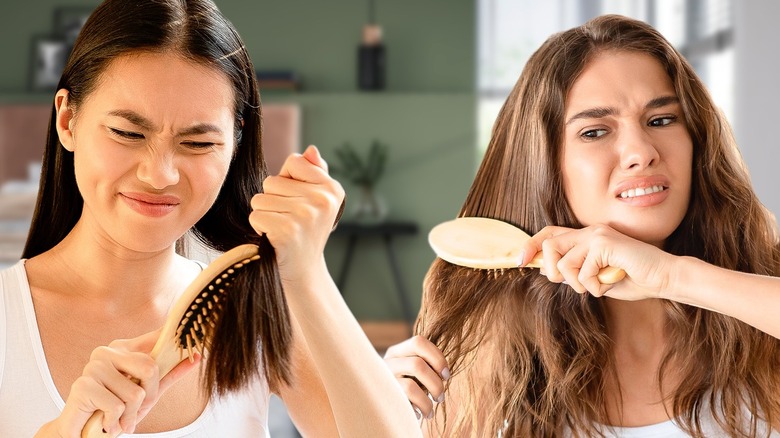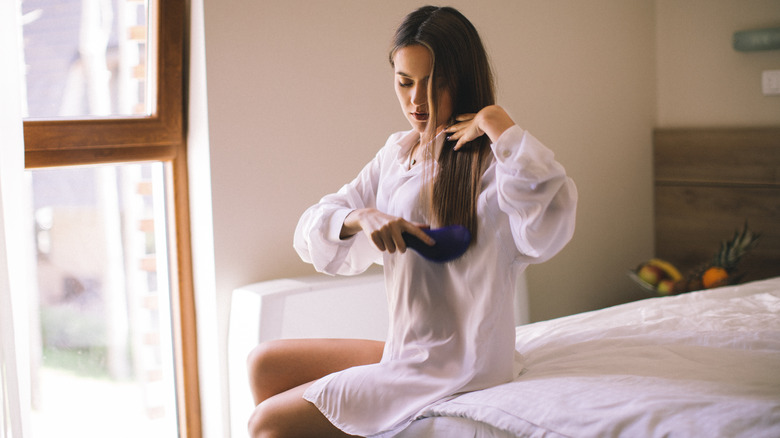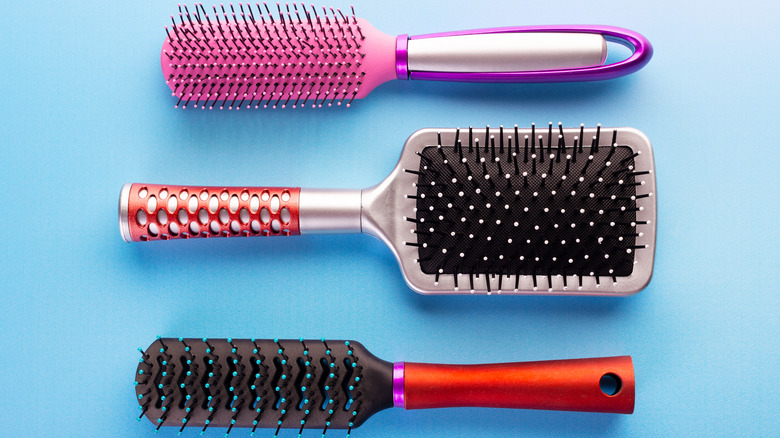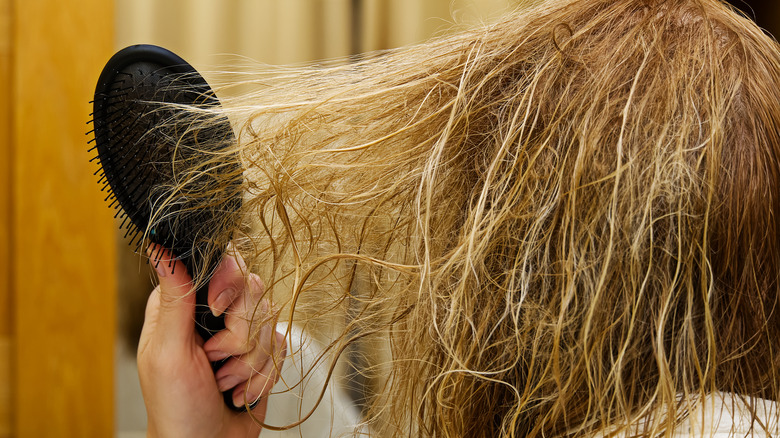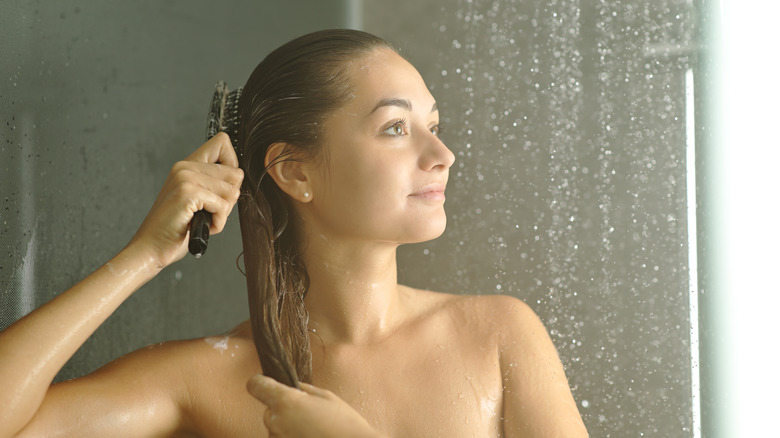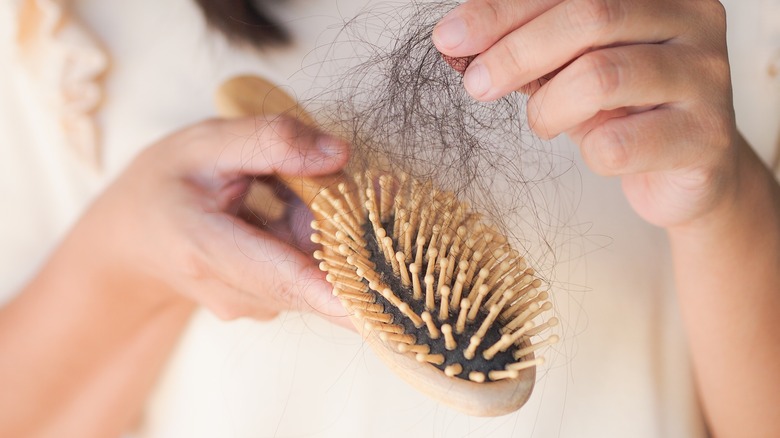All-Too-Common Hair-Brushing Mistakes You May Be Making
When it comes to their hair, many women take the same approach as with the rest of their beauty regimen. They carefully tailor their hair-treatment routine based on their hair's needs. They buy the appropriate hair products, such as shampoos and conditioners, apply occasional nutritious masks, trim the edges to keep the strands healthy, and visit the hair salon for expert advice.
However, when it comes to the way they brush their hair, these same individuals may rarely put any conscious thought into what they are doing. Brushing is brushing; what could possibly go wrong? Unfortunately, much like everything hair-related, the act of brushing is crucial, and making serious brushing mistakes can be detrimental to your beautiful locks.
Our head contains more than 100,000 hair follicles, and we typically lose anywhere between 50 and 100 hairs per 24 hours (via Healthline). Therefore, it's common to assume that the hair we see falling out while brushing is the result of natural shedding. However, what we mistakenly think is innocuous hair fall might actually be serious hair breakage due to our incorrect brushing technique. So, to protect your luscious mane and keep your hair vibrant and healthy, try to avoid these brushing mistakes at all costs.
Brushing the hair from top to bottom
Brushing your hair may seem like a no-brainer, starting from the top and working your way to the bottom. However, this actually leads to one of the most common hair-brushing mistakes you can make. While it may feel like you should start at the root of the hair and brush those tangles and knots away, this top-down approach causes unnecessary strain on the hair and leads to breakage.
Instead, Vincent De Marco, a celebrity hairstylist and the owner of Vincent Hair Artistry in Los Angeles, told Healthline that you should brush your hair in sections and begin mid-hair, slightly above the ends. "Brushing your hair from top to bottom will inevitably cause breakage. If your brush gets stuck, remove it and start again, gently," he suggested. Once the lower half of your hair is untangled, start brushing again a few inches higher than the first time and repeat until you reach the roots. After all the sections have been brushed and untangled, you can brush the entire length of your hair from the scalp to the ends a couple of times.
Using the wrong brush for your hair type
A brush may seem like a brush, but when it comes to keeping your hair healthy, shiny, and strong, choosing the right brush for your hair type is crucial (via Healthline). Think of it this way: when doing your makeup, you wouldn't use the same brush for everything, would you?
Fine hair – susceptible to brittleness and breakage – is best treated with extra-soft boar's bristle hair brushes to avoid further damage to tired and unhealthy locks. Thick and long hair, on the other hand, calls for a paddle brush that contains both boar's hair and nylon pins. The nylon pins can quickly brush through a thick mane while the boar's hair can up your locks' natural shine by helping disperse natural oils from the hair follicles across all hair lengths.
If you have thinning hair, opt for a soft bristle brush that will gently work through the tangles without ripping hair out from its follicles. For those who want to add some volume, use a teasing brush to access the roots. Curly hair is best brushed in the shower with a wide-toothed comb to fend off frizz and dryness. Lastly, straight hair – notorious for static – should be combed with a paddle brush that has a rubber pad.
Not using a brush for its intended purpose
Even if you find the right brush for your specific hair type and needs, this does not mean that you are all set and free to rest on your laurels. According to Luxy Hair, different brushes are crafted with specific purposes in mind and tailored to different hair types. For instance, a detangling hairbrush with flexible and softer bristles is specifically made for wet hair, gently moving through knots and tangles without causing breakage.
When blow drying, use a paddle brush for smooth, sleek hair, perfect for preparing your strands for flat-iron straightening. For a salon blowout effect, a round brush will be your BFF. Alternatively, you could go with a vented brush, which will also get the job done faster. "The space between the bristles allows ample airflow from the hair dryer to heat up and dry the hair quickly," hairstylist Adam Bogucki told Today.com.
A teasing hairbrush will add volume to your roots and is a great option for fine, thin hair. Use a wide-toothed comb for detangling wet, especially curly, hair. If you want to style dry curly hair, a boar's bristle brush is suitable. For parting hair into sections, either to brush it or straighten it with a flat iron, use a rat tail brush.
Brushing your hair when wet
Although there are brushes specifically designed for wet hair, it is best to avoid brushing your hair while it is soaking wet. "Don't brush your hair when it is wet, as that is when hair is most vulnerable," hairstylist and educator Jordan Mooney told Stylist. "You'll find that when the hair is damp, the shaft of your hair becomes weakened."
However, this doesn't mean you lack options. Garnier USA recommended waiting for your hair to air-dry after showering. Alternatively, you can use a microfiber towel to remove as much water as possible before using a special brush designed for wet hair to detangle your strands. These brushes have softer bristles and allow air to pass through them, which helps hair to air-dry as you detangle.
It's essential to use conditioner when washing your hair as well. Shampoo alone can dry out your hair, but conditioner provides extra protection and softness, making your locks less susceptible to damage while brushing. Using a detangling product before brushing can also help prevent damage.
Brushing your hair too often and too vigorously
Gone are the days when we thought that hair had to be brushed diligently 100 times a day for it to look healthy. This is a myth that has been debunked by the American Academy of Dermatology. Additionally, a 2009 study published in the Journal of Dermatological Treatment investigated the impact of brushing on hair loss. Participants brushed their hair at different rates per week for four weeks. At the end of the trial, the results showed that less frequent brushing resulted in less hair loss. Essentially, the more you brush your hair, the greater your chance of hair loss.
So, how often should you brush your hair? "Once in the morning and once in the evening before bed," consultant trichologist David Adams advised Sunday Edit. He suggested that individuals with long hair should consider a third brushing session around lunch. Texture also needs to be taken into consideration. "Curly hair is different [than straight hair]. Most of the time, people with curly and highly textured hair only brush their hair when it is time for a shampoo — not every day," Adams continued.
Further, intensity matters. Speaking to Healthline, De Marco warned that you should never brush your hair with force. "Vigorous brushing, even if only once a day, will cause breakage and damage your hair." Many of us brush too roughly on the scalp, but this results in not just breakage but also hair pulling.
